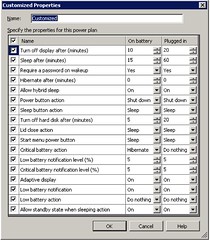Microsoft recently released in Beta the R3 version of its System Center Configuration Manager 2007.
Microsoft Corporate VP Brad Anderson, introduced it at the Microsoft Management Summit 2010 saying
The most significant change to the System Center Configuration Manager in R3 is the new power management set of strategies.
By way of background Brad talked about how an increasing number of RFP’s being received by Microsoft were requesting information on what Microsoft was doing to reduce its footprint. According to Brad, reducing your energy footprint is now an imperative to doing business, not just a way of saving the company money.
Microsoft’s System Center Configuration Manager allows systems administrators to centrally control all kinds of policies on client servers and PCs on a network. Everything from what appears in the Start menu right through to security management policies can be deployed using this software (aside – as a sysadmin of a small co. back in the early 00’s I used the config manager to set people’s wallpaper on their PCs to a html version of the co. phone book!).
The ability to control the energy policies of client PC’s is hugely important because that’s where the maximum number of CPU’s is in most organisations. The Ford Motor company, for example, recently announced that by rolling out 1E’s Nightwatchman PC energy management application it was going to save
$1.2 million and reduce its carbon footprint by 16,000-25,000 metric tons annually
1E are a Microsoft partner and their NightWatchman product goes significantly further with PC power management according to Microsoft’s Rob Reynolds, Director of Product Planning for System Center, who briefed me on the new System Center Configuration Manager (config manager will only put PC’s into Sleep Mode, for example, whereas NightWatchman can shut them down completely and NightWatchman has significant power management controls for XP clients which config manager is missing).
The new software gives you
- The ability to see and set how and where the power is being used
- The ability to see what your user activity looks like
- A set of recommendations on policy to show you how to reduce your power consumption and
- Tracking and reporting on how much carbon you have prevented from being released as a result of your power management capabilities
On the server front, Rob outlined a scenario where based on reduced demand (overnight, say), virtual machines can be re-provisioned onto fewer hosts and then some of the servers could be put into a low power state. Then as demand picks up once more (following morning) the servers in low power mode can be woken back up and the virtual machines moved back onto them.
While many products such as NightWatchman already exist with this functionality, having it built into Configuration Manager will now put this within easy reach of all Microsoft customers and that can only be a good thing.


To me this falls short, SCCM should have a much more mature feature set even if it steps on some of 1E’s toes. Most IT organizations cannot get a budget to pay for the ‘extra’ 1E solution (IT does not pay utility bills so it is a hard sell), this should be baked into all MS products and offered at no additional charge. I have many questions: Do their reports conform to GRI standards? Does it know based on IP address where employee are working (home office, NY, WA, CA) and determine what eGrid region to use in the US or international CO2e data? Can I run a report of Energy Star vs non-Energy Star computers to better justify sustainable procurement policies? What about display monitors, do they really know the type/ model and corresponding energy consumption? How about the remote workers, they may reduce their carbon footprint at home/hotel but does the reporting give the reduction credit to the company or separate the results into direct and indirect savings? Hopefully MS will clarify the offering this summer and add more management features ala 1E.
1E’s product is very cool but consumers should not have to pay extra for energy efficiency and cost/carbon savings, it is the hardware and OS manufacturer’s responsibility not a third party. I do like MS but Green IT needs more than this.